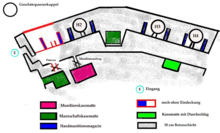Forte campomolon
The (unfinished) Forte Campomolon was intended as part of the Italian chain of fortifications in front of the height of the Seven Municipalities (Altopiano dei Sette Comuni) in the province of Vicenza .
The fragments are located on Monte Campomolon ( 1853 m ) about 6.5 kilometers east of the Austro-Hungarian fortifications Serrada and Sommo . The task would have been to cover the Valle Campiluzzi and Passo Tonezza to the south. The battery block had the shape of a so-called surface with two recessed flanks, each about 50 meters long. In each flank, two armored turrets were provided with a central spacing of 25 meters. The building was made of unreinforced concrete (see also: Forte Monte Verena ) and faced with limestone.
In the LEINGG (L'esercito italiano nella grande guerra) there is almost no information about the plant, which is probably related to the fact that it was not officially put into operation. Therefore, almost all figures refer to the observations of the kuk evidence bureaus and field records of the troops involved.
Construction phase
On May 1, 1911, construction of the facility began with earthmoving work (construction of a works road, leveling of the emplacement, etc.). On May 1, 1912, the reinforcement road was ready for use, but not yet fully completed. The crew quarters (a building about 70 meters long, located below the summit on Werksstrasse) and the gun depots were completed; a cistern was still under construction. The battery pack had not yet started in October.
On May 1, 1913, the Austro-Hungarian enemy reconnaissance stated that the initial work had ended and that, based on the observations made so far, an armored battery with four or six 149 mm A-turret guns and several armored machine gun stands had to be accepted. The armored domes are believed to be three-part and 180 millimeters thick.
Work on the battery block began in full in February; it could already be seen that the main direction of fire was to the north. The battery block was only one-story; the construction of the excavation against infantry attacks had not yet begun. Ultimately, only the entrance area adjoining the battery block with the standby rooms on the left was completed. Everything else was still in various stages of construction.
During the so-called neutrality phase from August 1914 to May 1915 (Italy initially refused to fulfill its alliance obligations and declared itself neutral), work was no longer carried out on the plant; Instead, a continuous ditch was created on the La Croce di Torao ( 1676 m ) contour line over Monte Campomolon to Soglio Melignone ( 1573 m ). Up to 600 workers were deployed here.
Fighting
After Italy declared war on Austria-Hungary on May 23, 1915, fighting began here too. On May 29, 1915, the heavy field howitzer battery 102 of the German Alpine Corps opened fire on Campomolon. In June and July 1915 a 30.5 cm mortar shelled the fort. There is evidence that four old 28 cm M79 C howitzers were set up in the area of the plant. A shot from the 30.5 cm mortar on the Forcella Molon hit a detached (relocated) ammunition depot, which exploded with tremendous force. More shots were fired at the facility, but only one shot hit casemate no. 13 of the only partially completed battery block. The 28 cm howitzers stopped firing, however.
In the course of the Austro-Hungarian May offensive in 1916 , the order to attack the next day was issued on the evening of May 18. Since the assessment of the combat strength of Campomolon was classified as very low by the Austro-Hungarian enemy reconnaissance, it was decided to attack the fort without further preparation. It was taken almost without a fight on the morning of May 19th. The retreating Italians carried out a few smaller explosions, particularly in the area of the barracks. The Sottotenente ( lieutenant ) Paolo Ferrario who was commissioned to do so may have destroyed a 149 mm cannon battery on the lower slope, where he was fatally wounded. The entrance block and the unfinished tank battery were not affected by explosions.
The armored domes intended for the plant had been ordered from Germany, but were not delivered due to the changed political situation. Since the construction of the Monte Rione plant had been canceled, the existing domes in Campomolon were to be installed. On June 20, 1916, the 3rd Infantry Division with Op. No. 164/17 that the armored domes near Cornolo had been blown up together with two 28 cm mounts.
The current ruin-like condition of the facility is not due to the effects of combat during the First World War. There is no explanation for this.
see also: Fights on the plateau of Lavarone (1915-1916)
Web links
literature
- Vienna State Archives / War Archives
- Carta Touristica Trento-Lévico-Lavarone. Compass Fleischmann S.ar. L. Istituto Geografico / Gardolo (Trento).
- Austria-Hungary's last war 1914–1918. Volumes I – IV, Verlag der Militärwissenschaftlichen Mitteilungen (Vienna 1933–1939).
- L'esercito italiano nella grande guerra (1915-1918). Volume I – III, Roma: Ministero della Guerra - Ufficio Storico 1929–1974.
- Robert Striffler: From Fort Maso to Porta Manazzo: History of the construction and war of the Italian forts and batteries 1883-1916. Book Service South Tyrol E. Kienesberger, Nuremberg 2004, ISBN 3-923995-24-5 .
- Rolf Hentzschel: Fortress war in the high mountains. Athesia, Bozen 2008, ISBN 978-88-8266-516-6 .
Coordinates: 45 ° 52 ′ 21.3 " N , 11 ° 17 ′ 5.7" E


